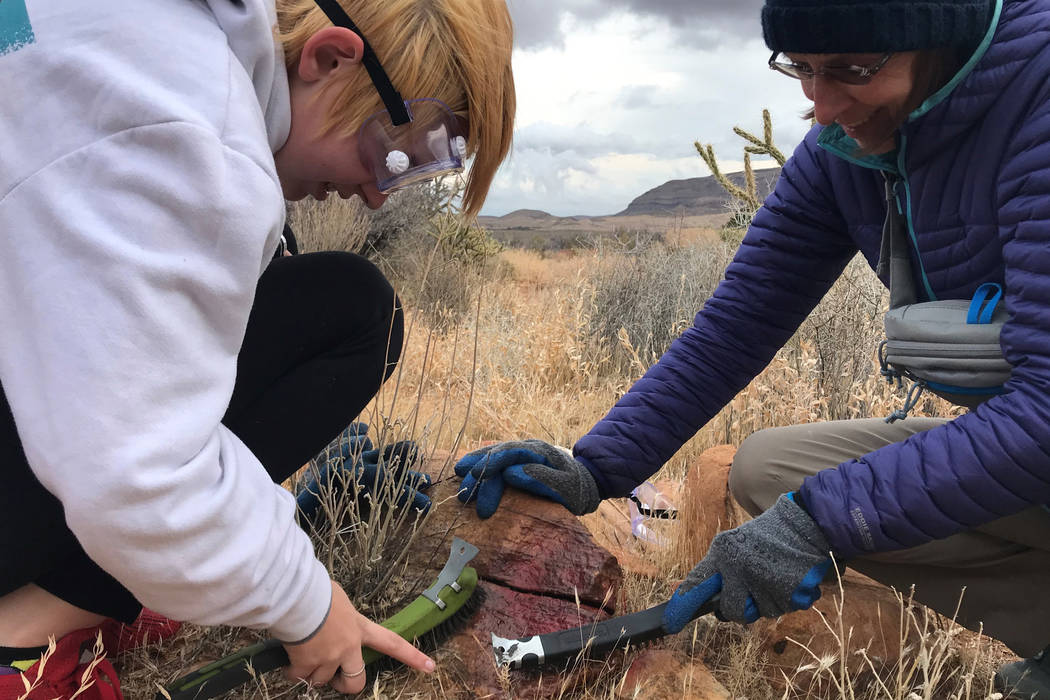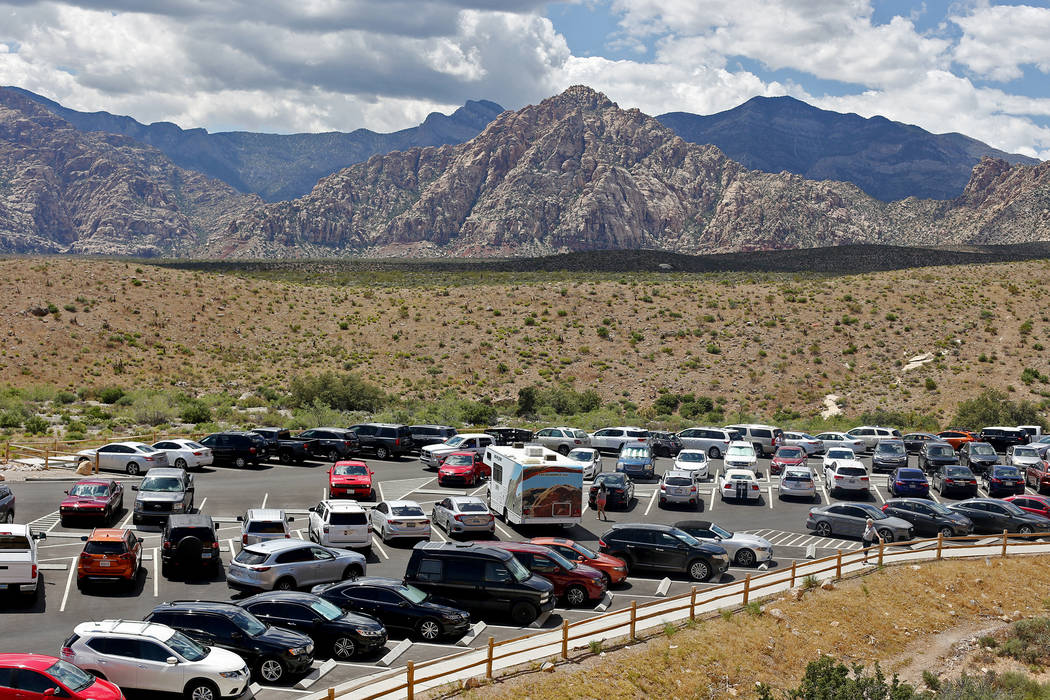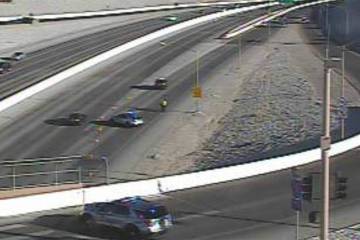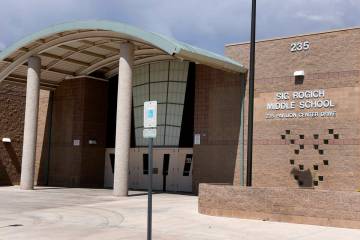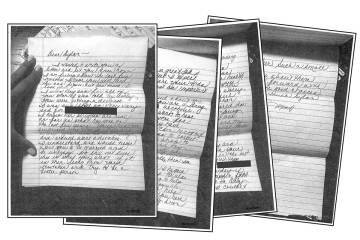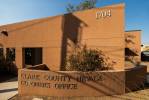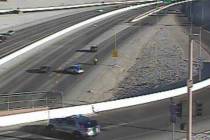Red Rock Canyon graffiti on rise, volunteers say
They’re armed with big yellow bags with gallons of water, spray bottles filled with an organic solution and lots of brushes.
For decades, Friends of Red Rock Canyon volunteers have quietly cleaned up graffiti on rocks along miles-long trails throughout the conservation area just west of Las Vegas. Annually, the group’s 400 members donate about 25,000 hours of manpower, Executive Director Erin McDermott estimated.
“It’s stellar there’s a committed group of volunteers who would do this, but I wish they didn’t have to,” McDermott said during a group outing to the Oak Creek Canyon trail in the Red Rock Canyon National Conservation Area on Dec. 8. There were about a dozen people dressed in bright neon clothing hiking up and down with equipment in their hands, that morning.
The Friends group is a “nonprofit for the purpose of assisting the Bureau of Land Management in developing and supervising a volunteer program,” according to its website. Designated in 1974, the club recently celebrated its 35th anniversary.
It’s one of several volunteer groups around the valley that help keep the surrounding mountains clean, such as Friends of the Nevada Wilderness and Friends of Sloan Canyon south of Las Vegas.
“We rely heavily on our partners,” said John Asselin, BLM public affairs specialist, adding that Friends of Red Rock Canyon covers most of the graffiti clean-up. The group’s members are also the ones primarily monitoring trails, looking for damage and cleaning up litter.
The nonprofit doesn’t have numbers for graffiti cases members have seen, but most volunteers believe they are seeing more as visits to Red Rock Canyon increase.
In 2018, the park had over 3.04 million visitors, about 900,000 more than the year prior. In 2011, the park had 1.16 million.
In May, the group made headlines when it offered a $3,000 reward for information leading to the arrest and conviction of anyone defacing Red Rock Canyon after volunteers found a large rock tagged with the names of several people and hearts. The offer still stands, according to McDermott, and is funded via donations and membership fees.
“The area is very fragile,” said Susan Beauchamp, graffiti removal coordinator. In addition to more cases of graffiti, the group is seeing more trash, dog feces and new trails made by visitors (Friends of Red Rock Canyon coordinates other outings to clean that up).
“That’s not good for the vegetation or animals,” Beauchamp added.
Unlike urban graffiti, which can be easier to see, spotting blobs of paint in the vast openness of the mountains can be difficult. For that, volunteers rely on BLM officials, their own experiences hiking up and down the trails before the outings, and reports filed on the Friends of Red Rock Canyon website.
“It’s not like train cars that are covered; it’s quite a bit smaller,” Asselin said, adding that seeing even one occurrence can ruin the experience of being in the outdoors.
Taggers create large murals, symbols and words, McDermott said, as about a dozen volunteers dressed in bright neon colors were busy at work cleaning up blobs of bright red spraypaint on rocks along the main trail.
It’s hard to make sense of what large red dots on the rocks mean; some volunteers believe they are trail markers. Other volunteers added that users might not understand that marking isn’t allowed on national conservation lands.
On this particular morning, each dot took about 10 minutes to remove. The mixture of lower temperatures and moisture made the job easier than usual.
The process is simple, said volunteer Brian Schuck.
Spray, scrub, rinse and repeat until all the paint is off.
It takes a lot of “elbow grease,” he said, scrubbing off a red dot on a rock. The area, accessible by gravel roads off of Highway 159 and 13-Mile Drive, is one of the most-tagged in the conservation area.
“Sometimes we have to work on a rock for an hour,” Schuck said. “One time we did a wall that said ‘Prom 2018.’ We did the whole wall in a morning.”
Brian and his wife, Beth, volunteer when the group is scheduled to go out about once a month — except during the summer, when Friends of Red Rock Canyon pauses its outdoor operations for the heat.
“We wanted to do something productive with our retirement,” Beth said of why they joined.
Other, more popular stops along 13-Mile Drive, such as the Calico Hills, don’t get hit as often, Asselin said.
For graffiti that is sprayed in the most remote areas, Friends of Red Rock Canyon will call in the cavalry – horseback riders — to ride out and clean off the graffiti. For tagging that is high up, the Southern Nevada Climbing Coalition is asked to volunteer and safely scale the cliffs and scrub it all off.
“It takes a village,” McDermott said.
Contact Alex Chhith at achhith@reviewjournal.com or 702-383-0290. Follow @alexchhith on Twitter.
Friends of Red Rock Canyon
To report cases of graffiti, email preserve@friendsofredrockcanyon.org or call 702-515-5360. The organization is offering a $3,000 award for the conviction of anyone who defaces the park.
There are multiple volunteer opportunities each month, involving tasks such as picking up trash and taking care of tortoises. For more information, go to friendsredrock.org.
Penalty on federal land
Under federal law, those convicted of a class A misdemeanor for vandalizing public lands can face a fine up to $100,000 or up to a year in jail, according to the Friends of Red Rock Canyon website.
What graffiti is
Graffiti is, loosely, unauthorized markings in public space. That includes writings or drawings scribbled, carved or sprayed on a wall or surface.
Visitors at Red Rock
Amid the rush of visitors to Red Rock Canyon National Conservation Area, volunteers have been seeing more cases of graffiti, trash, dog feces and off-the-path trails. Following is the number of reported visitors, by year.
1999: 1,127,500
2000: 1,153,500
2001: 765,000
2002: 1,135,800
2003: 1,240,600
2004: 880,100
2005: 845,100
2006: 866,200
2007: 837,200
2008: 748,400
2009: 901,000
2010: 1,066,600
2011: 1,115,300
2012: 1,022,200
2013: 2,021,000
2014: 1,753,300
2015: 2,420,700
2016: 2,221,100
2017: 2,137,600
2018: 3,040,300
Source: Bureau of Land Management



